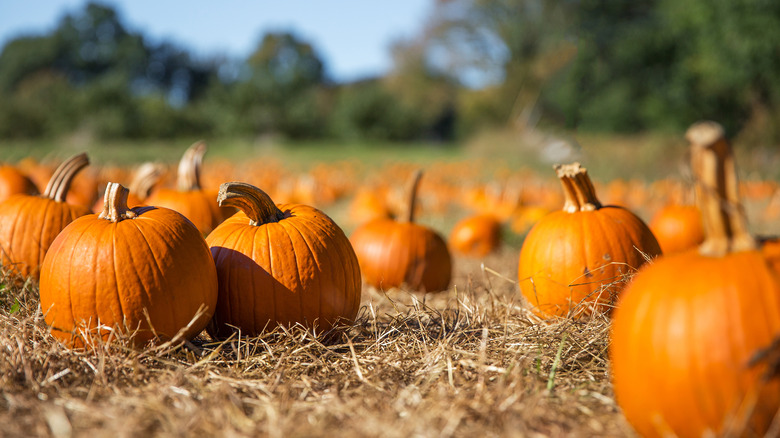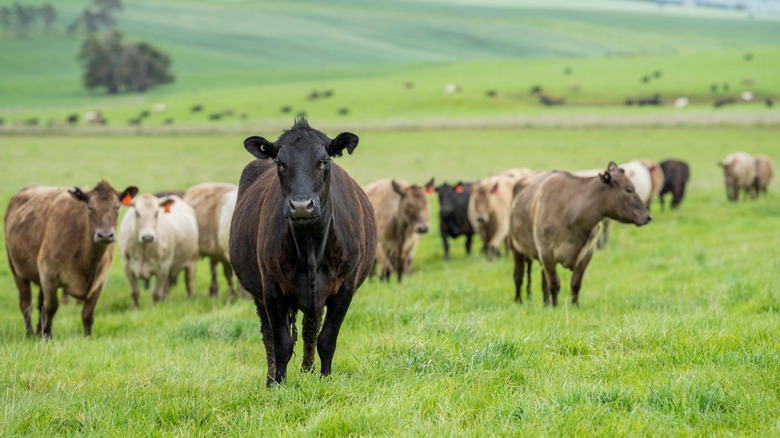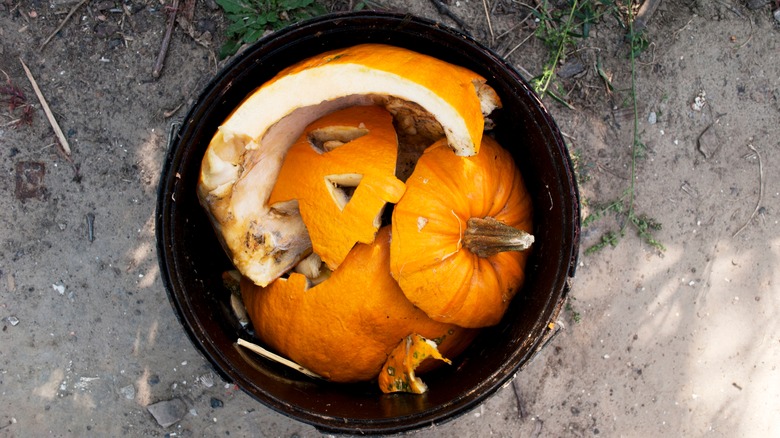Why Canned Pumpkin Could Hold The Key To Saving The Environment
By and large, we don't really think much about pumpkins until the fall, when Pumpkin Spice Latte season comes around, when we need Halloween decorations, or when it's time to plan a Thanksgiving meal. But for pumpkin farmers, the discourse around pumpkins needs to be a year-round thing — and it might be of comfort to know that they aren't just spending time growing pumpkins, they've been considering ways to make their processes more environmentally friendly, too.
One of these initiatives can be found in central Illinois, where canned food company Libby's is working with farmers with the goal of taking on more sustainable growing techniques. The end goal is to eventually have these pumpkin patches cut emissions and entice insects with the ability to help pollinate plants, all while boosting the health of their soil, per the Associated Press (AP). The skills and tactics farmers are using fall in the basket of regenerative agriculture, which Regeneration International says can "reverse climate change by rebuilding soil organic matter and restoring degraded soil biodiversity — resulting in both carbon drawdown and improving the water cycle."
Regenerative farming works on the principle of restoring soil to its natural state by using "holistic farming and grazing techniques," per AFN. The system encourages animals to wander around fields, breaking up soil and enriching it at the same time by leaving droppings; encouraging crop diversity; and avoiding disturbing the soil with synthetic and chemical fertilizers and pesticides.
Food conglomerates are experimenting with regenerative agriculture
Regenerative agriculture has shown plenty of promise and appears to work on a small scale, but AFN says is not yet known whether regenerative agriculture will work on larger agricultural systems. Still, that hasn't stopped companies like Libby's and its parent company Nestlé, as well as other food conglomerates like General Mills and Pepsico from trying. AP says General Mills is hoping to entice those working on 1 million acres of farmland to use regenerative agriculture by 2030; PepsiCo's goal is far more audacious because it seeks to have 7 million acres under the same farming system by the same deadline. Supporting farmers as they make the transition from conventional to regenerative farming is important because the USDA says it could take between three to five years for the technique to start delivering yields, per AP.
Libby's began experimenting with the system, which is said to have roots in indigenous farming techniques, in 2021 on 6,000 acres with 38 farmers. Nestlé environmental specialist Rachelle Malin says the experience has been enlightening. "We're learning more and we really want to go beyond. How can we build back some things we may have already lost in some previous practices?" she tells AP. And if these fields yield pumpkins this year, the pie filling that comes from these fields could have a much smaller carbon footprint than others you've had before.
Pumpkins have a large environmental impact
Using pumpkins to practice regenerative farming could also go some way into rehabilitating fall's favorite produce because while we all gravitate toward pumpkins during this time of year, our love for them is as time-limited as a PSL offer. The World Economic Forum says in Britain alone, of the 10 million pumpkins grown every year, 95% are tossed after Halloween, resulting in 18,000 tonnes of food waste. It's not much better in the United States, where 900,000 tonnes of pumpkin is tossed. These pumpkins end up in landfills where they start to rot and produce methane, making them environmentally problematic as a result.
Initiatives like this are also critical if we are to continue living off the land. The United Nations has already warned that given the amount of time needed to generate three centimeters of topsoil (1,000 years), if nothing changes, the world may be bereft of arable topsoil in as soon as 60 years, especially since a third of the world's topsoil can no longer be used, per Scientific American.
"We are losing 30 soccer fields of soil every minute, mostly due to intensive farming," farming activist Volkert Engelsman says. "Organic (farming) may not be the only solution but it's the single best (option) I can think of." But if regenerative farming works, that could be another option worth taking on.


